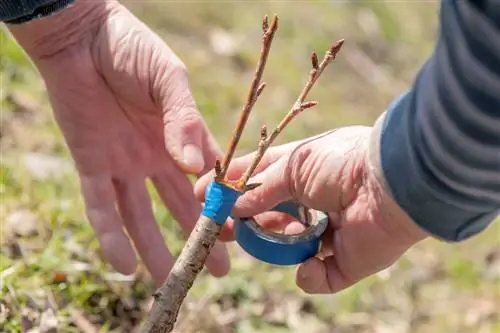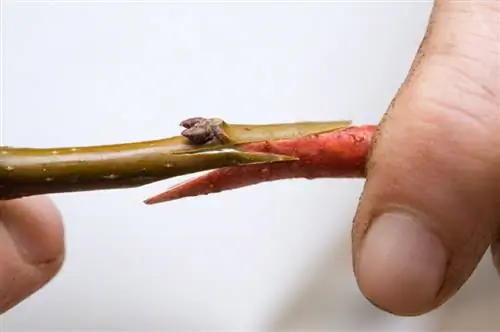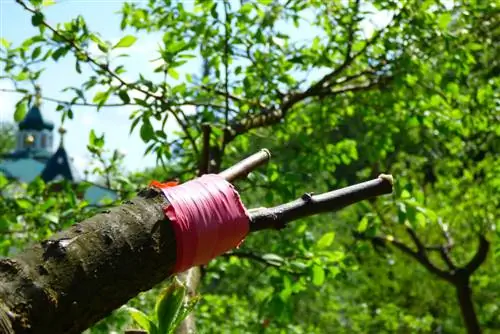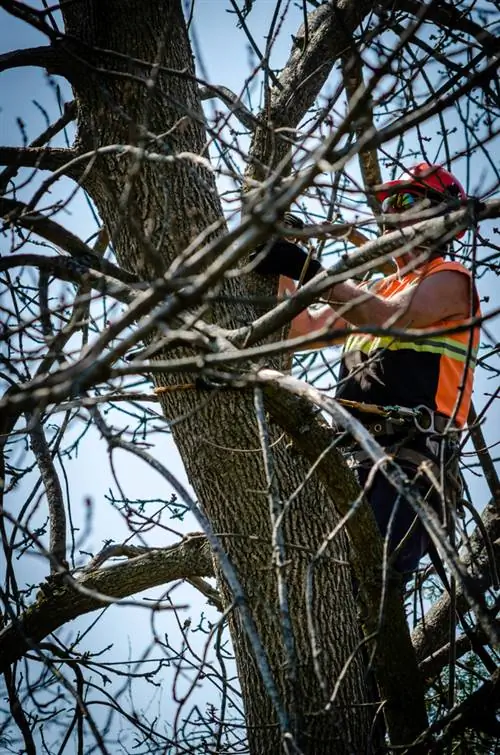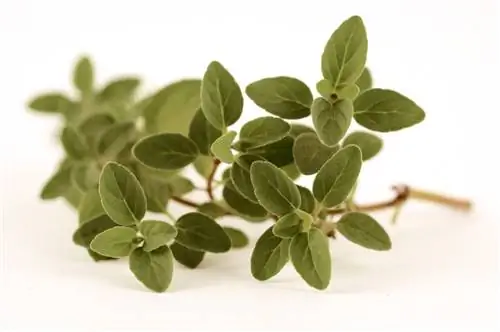- Author admin [email protected].
- Public 2023-12-16 16:46.
- Last modified 2025-01-23 11:21.
Refining is a form of propagation in which certain species can be grown in a single variety. This is not the case with seed propagation, as the mixed genetic material of the parent plants can always cause surprises. Even older trees can be re-grafted by removing as much of the crown as possible and grafting on a new one.
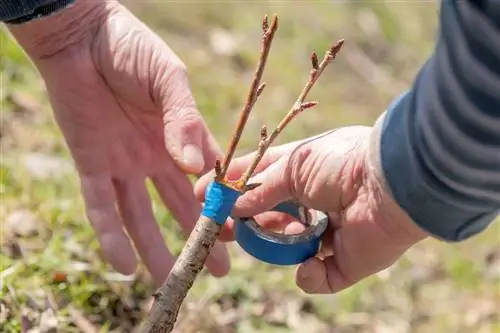
How can you graft trees?
Trees can be refined using various methods such as copulation, oculation and grafting behind the bark. Scions and suitable documents are used for this. Grafting should be done when vegetation is dormant or in spring, with sharp tools and good hygiene.
Tools and materials needed
First of all, the right tools and suitable materials are important for the success of the project.
Tools
When it comes to tools, you should use these:
- a copulating or butchering knife (€13.00 at Amazon)
- a pair of pruning shears (not anvil shears, they just squeeze the branches!)
- a saw
- Material for tying such as raffia or a finishing ribbon made of rubber or plastic
- Tree wax (cold spreadable)
The tool should be freshly sharpened and disinfected with alcohol or a disinfectant solution. An attempt at grafting often fails due to a lack of hygiene, which results in a fungal infection or similar and thus the scion fails to grow. The tool must be sharp because any bruising must be avoided - and the copulation cuts should, if possible, be made in one go and without any re-cutting.
Scion
Scion is the type of tree from which a new tree is to be grown. Annual shoots that are about pencil-thick and unbranched are best suited for this purpose. So-called water shooters can also be used, although the buds should not be too far apart. The latter often indicates that the shoots grew in a poorly exposed area of the tree. Scions are always cut fresh during winter dormancy (if possible in January). Depending on the process, the finishing takes place immediately or at a later date. Until then, you can store the rice in a cool and moist place - for example wrapped in a damp cloth in the refrigerator. Only buds intended for inoculation are cut in summer.
Documents
The gardener uses this term to describe the rootstocks onto which the noble varieties are grafted and which ultimately determine the growth behavior of the tree. The rootstocks can be weak, medium or strong, depending on whether you want to grow a small or large tree. In addition, thanks to a clever choice of rootstock, noble varieties that are unsuitable for certain soils can still be adapted - by making sure the rootstock matches the location. Wild forms of certain cultivars or self-grown seedlings of any size are often refined as rootstocks.
The best time
Most grafting methods are carried out during dormancy, which is the appropriate time for so-called scion grafting. Methods such as copulation, grafting or goatfoot grafting are traditionally carried out in January. In spring and summer you can then carry out inoculation or grafting behind the bark. Chip refinements are possible at any time of the year.
Various methods
There are numerous grafting methods, especially since every experienced gardener can certainly add their own secret tricks. Below we will describe the most common methods in a short guide, which are easy to carry out even for beginners. It is advisable to first practice the necessary cutting techniques on thin willow branches or on leftover clippings.
copulation
Copulation is also described as “refinement in the hand” and is one of the simplest procedures. For this you need a bare root base and a scion of the same thickness. First cut the base approximately ten centimeters above the root collar and opposite a bud. The cut should be about three centimeters long and run diagonally. Make the same cut with scion rice. Now place the cut surfaces on top of each other - they must fit exactly and wrap the scions with a band to stabilize them. Then spread tree wax over the finishing area.
Oculation
Occulation is also quite uncomplicated and is mainly used in rose and fruit tree cultivation. By the way, this is not about crossing two varieties - you just use one variety as a rootstock and, if necessary, as a stem former. The actual oculation takes place between July and August:
- Insert a T-cut into the bark of the base at the desired height of the graft (usually just above the ground).
- To do this, just cut into the Cambrian, the green part.
- Under no circumstances cut deep into the wood.
- Carefully unfold the two wings of the T-section.
- Cut an eye out of the scion you have prepared.
- This should have no wood, just the thin layer of bark.
- Carefully slide the eye into the bark pocket from top to bottom.
- Separate any protruding parts flush with the horizontal bark cut.
- Wrap the whole thing with an occlusal plaster or finishing tape.
- The eye should remain free.
Grafting behind the bark
If the stem of the rootstock is significantly thicker than the diameter of the scion, you can connect both parts by grafting behind the bark. A good time for this measure is spring between mid-April and mid-May, although the bark must be easy to remove.
- Make a smooth copulation cut on the scion(s).
- Cut the base to the desired height.
- Make a longitudinal cut in the bark at the top.
- This should be as long as the copulation cut of the scion.
- Carefully push the scion into the resulting pocket.
- Connect the processing office.
- Apply tree wax to all open interfaces.
Tip
If the refinement was successful, the scion or lye will sprout after a few weeks. However, if it dries up, you will have to repeat the process.

